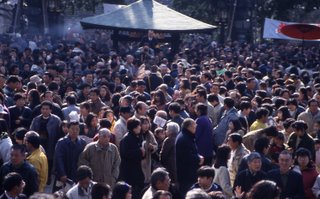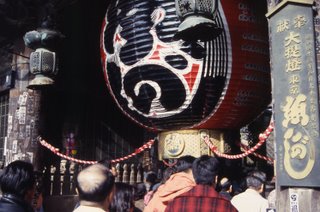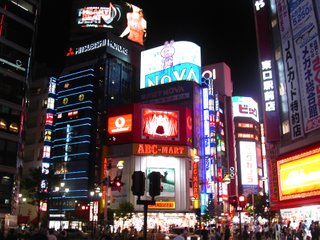

Asakusa
Pictured: Asakusa Gong, and Asakusa Street scene, courtesy of Fuji Film Staff
"Centered around Sensoji Temple with a history of 1,400 Years, the Asakusa district represents Tokyo`s old downtown, steeped in the nostalgic atmosphere of Edo-period while retaining a variety of traditional arts and crafts. The narrow streets leading to the temple are called "Nakamise" and are lined with colorful shops and stalls. Thronged with temple visitors and tourists year round, the "Nakamise" area comes especially alive during the festival season. Asakusa is truly enjoyable -- for delights of the palate at long-established restaurants, for strolling along side streets, and much more. Come visit Asakusa, and experience the centuries -old nostalgia of long ago Tokyo."--Oohisa, Iizumi, Tokyo Metropolitan S.G.G Club
It`s an interesting area that can be explored on foot. It is one of the few areas of Tokyo that has retained its feeling of history. A walk to Senso-ji (temple) can give one a glimpse of what Tokyo must have been like many years ago.
In Senso-ji one can see the Buddhist Goddess of Mercy, which according to legend wasrescued from the Sumida River in 628 AD. You can get to the temple from Asakusa SubwayStation. On Nakamise Street you can find Edo style crafts. Edo was one of the significant eras of Japanese history preceding the Meiji era. Edo was also the old name of Tokyo and the era was named Edo because of Tokyo`s preeminence at that time--and of course her preeminence continues today.
Sumida River Cruise
It is an interesting cruise if not the most picturesque. My wife and I enjoyed it and felt we understood Tokyo better from doing it. The cruise leaves from next to Azuma Bridge in Asakusa and goes to Hamarikyu-teien and Hinode Pier. If you go to the former,you can see a lovely garden for a smalll fee. After seeing the garden you can walk around Ginza which is an interesting shopping area.
Akihabara
If you are interested in electronic toys and gizmos then you really must visit Akihabara. If you aren`t then you don`t need to go here. Tourist frequent the area looking to buy things not available at home or to see the amazing variety of electronic goods all in one area. In contract to many cities in North America, Akihabara is like a city of electronics stores. Side by side you can visit store after store, selling everything from TVs, portable stereos, video and computer games to anything imaginable thatruns on electric current. You can ask for duty free items and there are many stores that cater solely to duty free buyers. Take the Electric Town exit from Akihabara Station (Yamanote Line). Be sure to bargain, you can sometimes get a discount. No where else in the world will you find the range of products you can find in Akihabara and you can literally spend the day here. I have!
Ueno
The only reason perhaps to visit Ueno unless you live in Tokyo is for the museums. I enjoy it myself for shopping and just walking around, but as a tourist, unless you are a museum buff, I wouldn`t bother going to the area. The movie "The Last Samurai," was perhaps based on an incident that occurred in Ueno Park, the last ditch battle by 2000 of Tokugawa`s Samurai versus The Imperial Army.
The museums of Japan are generally much smaller than in Western countries. They tend to be more specialized too. The Tokyo National Museum Tel. 3272-8600 This is Japan`s largest museum and worth a visit. It has the largest collection of Japanese Art in the world, as well as a collection of artifacts from Asia. Entry is free on the second Saturday of each month.
You can also reach nearby Asakusa quit quickly fron Ueno so you may wish to pair a visit to the two.
Shinjuku
 Picture of Shinjuku courtesy of Fuji Film staff
Picture of Shinjuku courtesy of Fuji Film staff"It is the most popular amusement center and one of the largest night-cities in the world. Here are bars--thousands of them--cabarets, clubs, restaurants, theatres, coffee shops, a whole city within a city served by the most crowede railway station in the whole country. Here too is the most spectacularaspect of modern Tokyo...." --Intoducing Japan, Donald Richie
"If you had only a day in Tokyo and wanted to dive headfirst into the modern Japanese phenomenon, Shinjuku would be the place to go. Nearly everything that makes Tokyo interesting rubs elbows here:high-class department stores, discount shopping arcades, flashing neon, government offices, swarming push-and-shove crowds, street-side video screens, stand-up noodle bars, hostess clubs, tucked-awayshrines and sleazy strip bars."--Japan, Lonely Planet
Shinjuku`s East Side
Just wandering around the area is interesting. If you exit the East Exit of Shinjuku Station you will find department stores, camera shops, and more. Kabuki-cho, the most infamous red-light district of Japan is east of Seibu Shinjuku Station and North of Yasukuni Street. The range of "adult" entertainment is mind boggling. In mostplaces, tourists from outside of Japan are not permitted entry, but it is still interesting to visit the area.You can also find movie theatres and some good restaurants and bars around.
Shibuya (Yamamote Line)
A youth oriented area known for entertainment, restaurants, movie theatres, bars, night clubs and shopping. It is usually extremely crowded and tourists can often be seen photographing the large intersection near the Hachiko Exit(Hachiko is the statue of a famous dog) of Shibuya Station, as the sight of thousands of people crossing the street is very interesting, especially if you come from Spud City, Idaho!
Shibuya is an area that has Love Hotels. The unique hotels, couples here often use for ashort time, if you know what I mean, nudge, nudge... You can seem some of the gaudy yetinteresting architecture of some of the hotels North of Shibuya Station up the hill.Take the Hachiko exit and head North. Tokyo National Museum
No comments:
Post a Comment